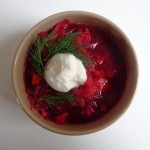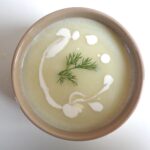 This dish of chicken in a creamy paprika sauce came about as a result of current events. I thought I’d like to make something Ukrainian in honor of a besieged nation, and I also wanted to add to the poultry dishes already on this site. My first idea, rather naturally, was chicken Kyiv (suprêmes de volaille à la Kyiv). But a little research showed that this dish, which by the way is quite complicated to make, is actually Russian in origin. Nyet.
This dish of chicken in a creamy paprika sauce came about as a result of current events. I thought I’d like to make something Ukrainian in honor of a besieged nation, and I also wanted to add to the poultry dishes already on this site. My first idea, rather naturally, was chicken Kyiv (suprêmes de volaille à la Kyiv). But a little research showed that this dish, which by the way is quite complicated to make, is actually Russian in origin. Nyet.
Poulet au paprika / Chicken with paprika
So I did a little more research and came up with a French version of chicken paprikash, a dish served across central and eastern Europe. The chicken is sautéd with onions, paprika, seasonings and a spritz of lemon juice, then water is added and the dish is simmered to tenderness, with cream stirred in at the end. Topped with fresh herbs and served over tiny pasta or rice, it’s a simple, satisfying dish that can be made in about half an hour.
Like so many people around the world, I’ve been horrified and heartbroken by Russia’s unprovoked war on Ukraine, all the more so because I’m attached to both cultures in one way or another — I worked in Russia for five years as a journalist and I also have Ukrainian roots. For the last month or so I’ve dealt with my personal distress by working with the French Red Cross to help Ukrainian refugees as they arrive at Paris train stations. Last week a high school classmate asked me to write about this for his newsletter. If you’d like to see my thoughts on the situation, I posted the piece online. Click here.
My Ukrainian roots come from my father’s side of the family — Jews who emigrated to the United States in the 1890s. My father’s paternal grandmother, Sarah Bortin, always said she came from Odessa. Only much later in life did I learn that when she said she came from Odessa, she meant that the boat for America sailed from Odessa. That branch of the family actually came from a small Jewish village near Berdichev, about 120 miles west of Kyiv. My father’s maternal grandparents also came from various parts of Ukraine. It is to my father’s mother, my Grandma Anne, that I owe my familiarity with Ukrainian cuisine.
 Grandma Anne was a good cook, although her imprecision with measurements drove my mother crazy. For example, her recipe for syrniki — little pancakes made with smooth cottage cheese and served with sour cream and jam — calls for ‘one half eggshell water’. I’d like to post this family recipe here one of these days, along with two more, Grandma Anne’s fabulous stuffed cabbages and her wonderful cheesecake.
Grandma Anne was a good cook, although her imprecision with measurements drove my mother crazy. For example, her recipe for syrniki — little pancakes made with smooth cottage cheese and served with sour cream and jam — calls for ‘one half eggshell water’. I’d like to post this family recipe here one of these days, along with two more, Grandma Anne’s fabulous stuffed cabbages and her wonderful cheesecake.  Meantime when thinking about today’s post I was surprised to realize that I’ve already posted two Ukrainian dishes on this site — borshch and potato pancakes.
Meantime when thinking about today’s post I was surprised to realize that I’ve already posted two Ukrainian dishes on this site — borshch and potato pancakes.
If you’d like to make an all-Ukrainian dinner during these dark weeks, you could start with potato pancakes (often served with applesauce on the side), follow with borshch and have the chicken with paprika as the main dish. For dessert, although not strictly Ukrainian, you could serve mini cherry cheesecakes made with goat cheese.
 Happy cooking.
Happy cooking.

 I discovered this spicy peanut-topped cucumber salad just as Sichuan cuisine began making it big in Paris. It’s on the menu of
I discovered this spicy peanut-topped cucumber salad just as Sichuan cuisine began making it big in Paris. It’s on the menu of  The key ingredient in this salad, as in many Sichuan recipes, is Sichuan peppercorn. It looks different from black peppercorn in that it’s a reddish brown and more wrinkled. Unlike hot red peppers (piments in French), Sichuan peppercorn is described as numbing rather than fiery. And its flavor is just unbeatable. You can find it at Asian grocery shops.
The key ingredient in this salad, as in many Sichuan recipes, is Sichuan peppercorn. It looks different from black peppercorn in that it’s a reddish brown and more wrinkled. Unlike hot red peppers (piments in French), Sichuan peppercorn is described as numbing rather than fiery. And its flavor is just unbeatable. You can find it at Asian grocery shops. The other day I decided to try to recreate a dish I vaguely remembered — cod with chickpeas, spinach and chorizo chips. It felt just right for a brisk, pre-spring sunny day. I checked my favorite Spanish cookbook, couldn’t find it. Ditto my Portuguese cookbook. Then I looked online, and found not a single recipe for this precise combination. So I winged it. Well, dear readers, my guest was happy. And in fact so was I.
The other day I decided to try to recreate a dish I vaguely remembered — cod with chickpeas, spinach and chorizo chips. It felt just right for a brisk, pre-spring sunny day. I checked my favorite Spanish cookbook, couldn’t find it. Ditto my Portuguese cookbook. Then I looked online, and found not a single recipe for this precise combination. So I winged it. Well, dear readers, my guest was happy. And in fact so was I. So whatever the origin of this particular dish, the flavors blend well. And, as I discovered, it is not just easy to make but has the significant advantage of being able to be prepared in advance. If you cook the chickpeas yourself — highly recommended — it’s best to start the evening before you plan to serve the dish. Tips on cooking chickpeas may be found
So whatever the origin of this particular dish, the flavors blend well. And, as I discovered, it is not just easy to make but has the significant advantage of being able to be prepared in advance. If you cook the chickpeas yourself — highly recommended — it’s best to start the evening before you plan to serve the dish. Tips on cooking chickpeas may be found  Flamiche is a savory tart from Picardie made of leeks and cream encased in puff pastry. This is comfort food at its finest, perfect for cool days or nights as we wait for spring. Flamiche can stand on its own as a lunch dish or may be served as a starter in the evening, accompanied by a fruity red. Its versatility makes it a winner. Yet this pie from Picardie is rarely encountered in other parts of France, not to mention the rest of the world.
Flamiche is a savory tart from Picardie made of leeks and cream encased in puff pastry. This is comfort food at its finest, perfect for cool days or nights as we wait for spring. Flamiche can stand on its own as a lunch dish or may be served as a starter in the evening, accompanied by a fruity red. Its versatility makes it a winner. Yet this pie from Picardie is rarely encountered in other parts of France, not to mention the rest of the world. This light, refreshing dessert of orange slices in a flavorful syrup is best in winter, when large sweet oranges are in season. I first tasted it at the home of my neighbor Manuela, a superior cook. But on that occasion she barely cooked. The main course was a platter of oysters and langoustines straight from the market. She followed up with the sliced oranges, which were so delightful I had to have the recipe. The star ingredient was star anise.
This light, refreshing dessert of orange slices in a flavorful syrup is best in winter, when large sweet oranges are in season. I first tasted it at the home of my neighbor Manuela, a superior cook. But on that occasion she barely cooked. The main course was a platter of oysters and langoustines straight from the market. She followed up with the sliced oranges, which were so delightful I had to have the recipe. The star ingredient was star anise. Hiding beneath its rather grand name, potage Parmentier is familiar to every child in France as potage poireaux-pommes de terre, or creamy leek-and-potato soup. It takes its name from Antoine Parmentier, who won royal approval of the potato (seriously!) on the eve of the revolution that toppled the kings of France. The soup — which unlike vichyssoise is served hot — makes a satisfying, and some would say elegant, winter dish.
Hiding beneath its rather grand name, potage Parmentier is familiar to every child in France as potage poireaux-pommes de terre, or creamy leek-and-potato soup. It takes its name from Antoine Parmentier, who won royal approval of the potato (seriously!) on the eve of the revolution that toppled the kings of France. The soup — which unlike vichyssoise is served hot — makes a satisfying, and some would say elegant, winter dish. Bourride is a Mediterranean fish dish bathed in a sauce infused with garlic and inflected with hints of orange and sunshine. If you’ve been to the French Riviera you may have had the luck to encounter it. Elsewhere there’s little chance you would have run into this undeservedly lesser known cousin of bouillabaisse. I’ve rarely seen it in restaurants in Paris. Which is why, shortly after tasting it for the first time, I learned how to make it.
Bourride is a Mediterranean fish dish bathed in a sauce infused with garlic and inflected with hints of orange and sunshine. If you’ve been to the French Riviera you may have had the luck to encounter it. Elsewhere there’s little chance you would have run into this undeservedly lesser known cousin of bouillabaisse. I’ve rarely seen it in restaurants in Paris. Which is why, shortly after tasting it for the first time, I learned how to make it. Stuffed eggs topped with red caviar make a simple yet elegant dish that’s perfect for special occasions. Do I hear New Year’s Eve, anyone? Or brunch on the morning after? Most French takes on this dish call for the eggs to be scrambled. This recipe, with hard-boiled eggs, has a more Russian flavor. In the old days, Russians often served the eggs topped with black caviar — but with the sturgeon now an endangered species, red caviar is used instead.
Stuffed eggs topped with red caviar make a simple yet elegant dish that’s perfect for special occasions. Do I hear New Year’s Eve, anyone? Or brunch on the morning after? Most French takes on this dish call for the eggs to be scrambled. This recipe, with hard-boiled eggs, has a more Russian flavor. In the old days, Russians often served the eggs topped with black caviar — but with the sturgeon now an endangered species, red caviar is used instead. On occasions like New Year’s Eve, the eggs may be served as part of an hors d’oeuvre spread. They would marry well with
On occasions like New Year’s Eve, the eggs may be served as part of an hors d’oeuvre spread. They would marry well with  If you’d like to serve something different this holiday season, why not consider côte de boeuf? A bone-in rib of beef that is served as steak, and not as a roast, côte de boeuf is a popular cut is France. It is ultratender, flavorful and easy to prepare. If you can convince your butcher to cut the meat as the French do, then this elegant dish would make a lovely centerpiece to a festive meal, perhaps accompanied, as shown here, by a cauliflower gratin.
If you’d like to serve something different this holiday season, why not consider côte de boeuf? A bone-in rib of beef that is served as steak, and not as a roast, côte de boeuf is a popular cut is France. It is ultratender, flavorful and easy to prepare. If you can convince your butcher to cut the meat as the French do, then this elegant dish would make a lovely centerpiece to a festive meal, perhaps accompanied, as shown here, by a cauliflower gratin. A côte de boeuf is the equivalent of an American ribeye steak, with the bone included. It is prepared in two stages. First the meat is pan-seared to seal in the juices. It is then roasted for a relatively short time in a very hot oven, allowed to rest briefly and sliced off the bone. Nothing is added until the very end, when the meat is salted and peppered. When buying the rib pictured here, I asked Marie Pacaud, who presides over the excellent Boucherie du Marais, whether to rub the meat with garlic. I received the French equivalent of fuhgeddaboudit: the Gallic shrug. ‘That would distort the flavor,’ she said drily.
A côte de boeuf is the equivalent of an American ribeye steak, with the bone included. It is prepared in two stages. First the meat is pan-seared to seal in the juices. It is then roasted for a relatively short time in a very hot oven, allowed to rest briefly and sliced off the bone. Nothing is added until the very end, when the meat is salted and peppered. When buying the rib pictured here, I asked Marie Pacaud, who presides over the excellent Boucherie du Marais, whether to rub the meat with garlic. I received the French equivalent of fuhgeddaboudit: the Gallic shrug. ‘That would distort the flavor,’ she said drily.
 This unusual wild mushroom risotto is the creation of John O’Shea, the brilliant young British chef who presides over the kitchen at JJ Beaumarchais, a restaurant downstairs from my apartment. It is unusual first because instead of rice it uses épeautre, known in English variously as spelt or einkorn wheat, and second because, unlike most risottos, the ingredients are cooked separately and combined only just before serving.
This unusual wild mushroom risotto is the creation of John O’Shea, the brilliant young British chef who presides over the kitchen at JJ Beaumarchais, a restaurant downstairs from my apartment. It is unusual first because instead of rice it uses épeautre, known in English variously as spelt or einkorn wheat, and second because, unlike most risottos, the ingredients are cooked separately and combined only just before serving. I made the dish three times last month, using a different combination of mushrooms each time. Pictured at right are four types I’ve tried. Going clockwise from the top left, they are in French, chanterelles, pleurotes, shitake and girolles. This may be a bit confusing, because what the French call girolles are called ‘chanterelles’ in English. But it doesn’t matter because you can use whatever is available in your area. I have also used the papery black mushrooms called trompettes de la mort (‘trumpets of death’), which despite their scary name are not poisonous and are indeed very popular over here.
I made the dish three times last month, using a different combination of mushrooms each time. Pictured at right are four types I’ve tried. Going clockwise from the top left, they are in French, chanterelles, pleurotes, shitake and girolles. This may be a bit confusing, because what the French call girolles are called ‘chanterelles’ in English. But it doesn’t matter because you can use whatever is available in your area. I have also used the papery black mushrooms called trompettes de la mort (‘trumpets of death’), which despite their scary name are not poisonous and are indeed very popular over here.

